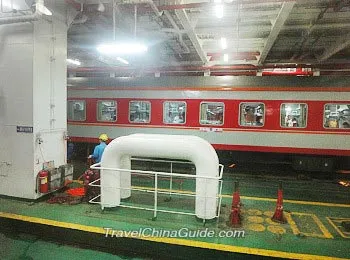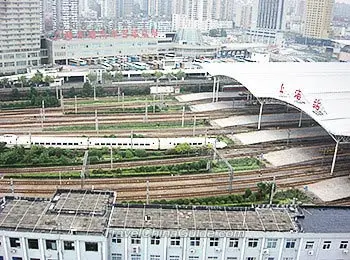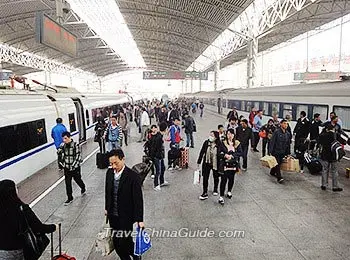China Railway Infrastructures
China railway infrastructures include railway tracks the train running on, bridges and tunnels the tracks traversing through, train stations passengers getting on and off, and trains accommodating passengers.
Thanks to years’ construction on the vast and complex terrain, China has acquired advanced technologies of building railway infrastructures, and has finished many world-famous projects like Tibet Railway, bullet trains as fast as 605 km/h (376mph), and Danyang - Kunshan railway bridge with a length of about 160 km (100 mi).
By then end of 2025, there have been more than 165,000 km (102,525 mi) of rail track in operation in China, among which over 50,000 km (31,069 mi) are high speed lines. Most lines adopt the standard specification on the track gauge, 1,435 millimeters (4 feet 7 inches) width, which is used by word’s 60 percent countries. This specification unification is good for normalized operation of the whole rail system on this planet.
 Further Reading:
Further Reading:
China Railway Network
High Speed Rail Network
It was estimated that there were about 5,500 train stations in operation, including over 2,000 for passenger transport. According to the various geographical position and function, Chinese train stations can be divided into six classes, including principal, first, second, third, fourth and fifth classes. The main criterions of the division are based on the passenger and freight transport capacity, number of luggage transport, location of the station, etc. From the aspect of passenger transport, the principal class station can transport about 60,000 passengers every day, first class 15,000, second class 5,000, and 2,000 for third class station.
Generally speaking, there are two types of trains running on China’s rail lines; high-speed and ordinary. The high-speed trains, prefixed with C/D/G are usually in white or silver; while the ordinary trains,, prefixed with Z/T/K/L/Y/S or only numbered with digits, are usually in blue, red or green with a little white or yellow. However, all ordinary trains will be gradually painted into dark green, with a light yellow strip crossed in the middle. Most of them are powered by electricity; only a few are dragged by diesel locomotive; and the steam locomotives can hardly be seen.
 Further Reading: China Train Types
Further Reading: China Train Types
Due to the diverse landform in China, the bridges, tunnels and ferries are massively utilized in the railway construction, especially in the terrain such as rivers, valleys and straits.
 Bridges
Bridges
By far, there are over 47,000 railway bridges open to the traffic in China; and about 900 of them are long span ones (It is regulated that bridges over 546 yards, 500 meters, long can be regarded as long span bridges). Among them, the longest is the Danyang-Kunshan Bridge, served as a section of Beijing-Shanghai High Speed Railway, with a total length of 165 km (102 mi).
 Tunnels
Tunnels
There are three kinds of tunnels applied in the rail work construction, including through-mountain, through sea and river, and city underground tunnels; among which the mountain tunnels occupy the most proportion. Most tunnel projects are clustered in Sichuan, Shaanxi, Yunnan and Guizhou Provinces. The tunnels in the Chengdu-Kunming line are about 342 km (212 mi), occupying 31.6 percent of the total length of the line. Another tunnel along Xiangyang-Chongqing line, with a length of 282 km (175 mi), takes up 34.3 percent of the total length. According to recent statistics, there are about 6,102 tunnels in total in China mainland. For now,
the longest one is the Xinguanjiao Tunnel along Tibet Railway with a length of 32.6 km (20 mi); the West Qingling Tunnel along Lanzhou-Chongqing line takes the second place with a length of 28.2 km (17.5 mi).
 Ferries
Ferries
To be simple, the ferry railroad refers to track constructed on ships which can accommodate trains to go across the rivers and straits. There is one most well-known cross-sea ferry line in China, the Yuehai Railway over Qiongzhou Strait. There will be also another cross-sea line through Bohai Sea Strait in the near futuere. In addition, there are densely covered rivers that blocked the rail work construction, so the river ferry rail begins to emerge. The notable one is the Jiangyin Ferry railroad over the Yangtze River with a length of 6 km (3.7 mi) linking Jingjiang to Jiangyin. It is the only ferry line in operation in Yangtze River.
Thanks to years’ construction on the vast and complex terrain, China has acquired advanced technologies of building railway infrastructures, and has finished many world-famous projects like Tibet Railway, bullet trains as fast as 605 km/h (376mph), and Danyang - Kunshan railway bridge with a length of about 160 km (100 mi).
Railway Lines
China Railway Network
High Speed Rail Network
It was estimated that there were about 5,500 train stations in operation, including over 2,000 for passenger transport. According to the various geographical position and function, Chinese train stations can be divided into six classes, including principal, first, second, third, fourth and fifth classes. The main criterions of the division are based on the passenger and freight transport capacity, number of luggage transport, location of the station, etc. From the aspect of passenger transport, the principal class station can transport about 60,000 passengers every day, first class 15,000, second class 5,000, and 2,000 for third class station.
|
|
Trains
Bridges, Tunnels and Ferries
By far, there are over 47,000 railway bridges open to the traffic in China; and about 900 of them are long span ones (It is regulated that bridges over 546 yards, 500 meters, long can be regarded as long span bridges). Among them, the longest is the Danyang-Kunshan Bridge, served as a section of Beijing-Shanghai High Speed Railway, with a total length of 165 km (102 mi).
There are three kinds of tunnels applied in the rail work construction, including through-mountain, through sea and river, and city underground tunnels; among which the mountain tunnels occupy the most proportion. Most tunnel projects are clustered in Sichuan, Shaanxi, Yunnan and Guizhou Provinces. The tunnels in the Chengdu-Kunming line are about 342 km (212 mi), occupying 31.6 percent of the total length of the line. Another tunnel along Xiangyang-Chongqing line, with a length of 282 km (175 mi), takes up 34.3 percent of the total length. According to recent statistics, there are about 6,102 tunnels in total in China mainland. For now,
 |
| Yuehai Railway Ferry |
To be simple, the ferry railroad refers to track constructed on ships which can accommodate trains to go across the rivers and straits. There is one most well-known cross-sea ferry line in China, the Yuehai Railway over Qiongzhou Strait. There will be also another cross-sea line through Bohai Sea Strait in the near futuere. In addition, there are densely covered rivers that blocked the rail work construction, so the river ferry rail begins to emerge. The notable one is the Jiangyin Ferry railroad over the Yangtze River with a length of 6 km (3.7 mi) linking Jingjiang to Jiangyin. It is the only ferry line in operation in Yangtze River.
- Last updated on Jan. 16, 2026 by Brenda Lian -

